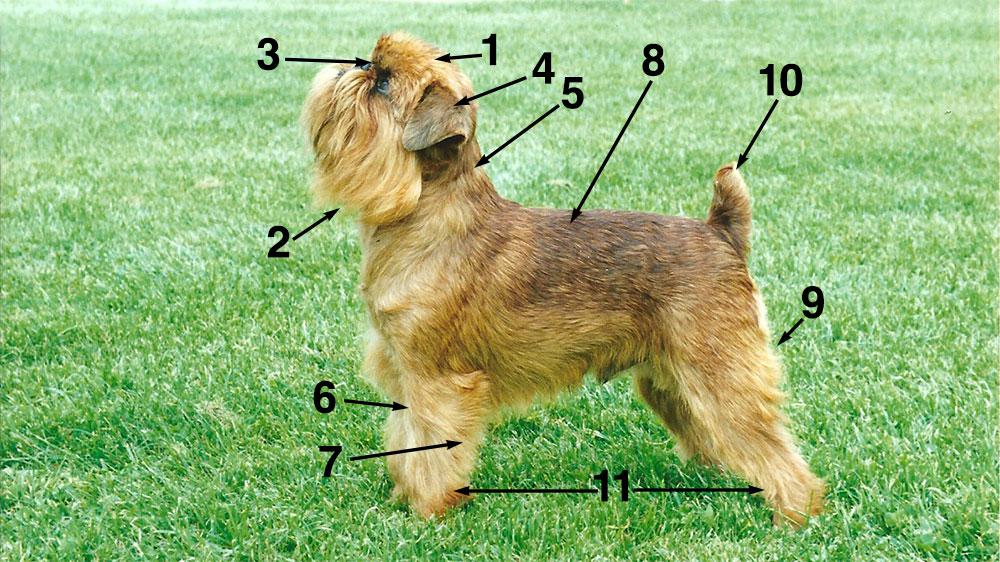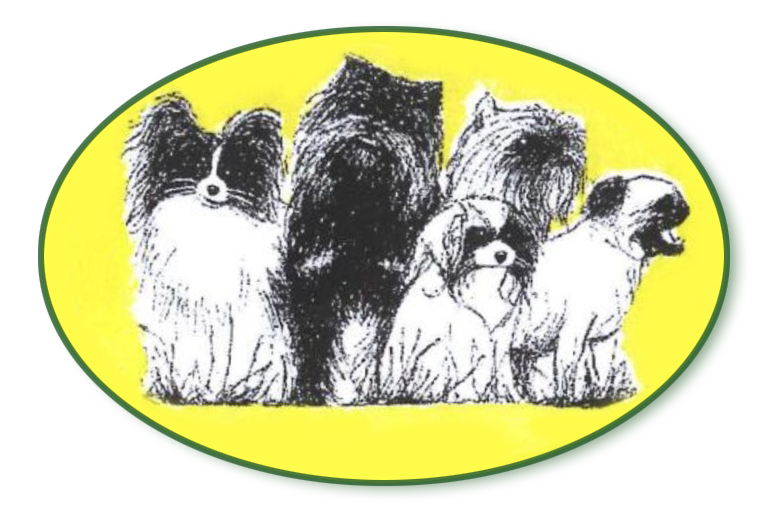
by Jetty van der Hulst
Preparing for show is not too difficult in this breed, it means grooming the Griffon to give it a well groomed finished look. But of course the dog has to be shown in a good hard coat. So before the show, only eliminate the protruding tufts and shorten the coat on the head, the ears, the feet and the area around the anus (this part always needs to be shortened well, because this makes the dog's body optically shorter). Never bath the Griffon before a show, because washing can make the coat softer. There must be sufficient coat on the dog, so a whole grooming session may not take place just before showing. Most dogs need at least ten or twelve weeks to come back into coat after a complete grooming session.
Remember that the Griffon Bruxellois or Griffon Belge is a sturdy little dog that should make a compact impression. He should certainly not make an exaggeratedly groomed impression like that of a Terrier.
1. Skull: pick out the hair above the nose and around the eyes. There are Griffons that have a beautiful hard coat, but on the skull thin fluffy hair. Still try to pick, because otherwise the hair will become softer. Sometimes this can be done in parts after consultation with the owner.
From the middle you work more and more to the side of the head to the outer corner of the eye and the bottom of the ear. The part below the ear can be shortened.
2. Beard: the beard falls round, so do not comb forward like with a Fox Terrier. The beard of the Griffon Bruxellois looks more like a so called seaman's beard or like a fringe of beard. It gives a more beautiful effect when the border of the beard is a bit more backwards than the line from eye to jaw. Make sure that there is never hair above the line from eye to ear (on the skull). This may seem complicated, but looking at pictures of heads can make clarify matters.
3. Stop: pluck away protruding hairs, also the hairs that are irritating the eyes.
4. Ears: here the hairs are generally very short. Pick carefully, if it doesn't work by hand, try with a finely toothed stripping knife. Pick out the hair in the ears.
5. Neck and shoulders: pluck, but not too short between the forelegs. Prevent the forming of an inlet between the forelegs.
6. Forelegs: Pluck. Especially the long soft hair should be removed. The Griffon has firm legs, so if there is some hard hair on it, it gives a nice effect. This is certainly the case on the back of the front legs. Make sure the hair is naturally shortened. So make sure the hair doesn't look like feathering (like the long hairs on the legs of a Spaniel).
7. Elbows: make sure that the outgrowing hair is plucked away, so that the elbows fit nicely. But also make sure it that it doesn't become bald, there is usually little or no hair in the armpits.
8. Back: Pluck. If the dog is somewhat finely built, leave a little hair under the chest, to make it look a bit deeper. The chest must reach to the elbows.
9. Hind legs: again, pick out all the long hairs, but to prevent the legs from looking too thin, possibly leave the hair a little longer at the front edge of the leg and the part of the hock towards the foot. The back of the leg is shortened well until the hock.
10. Tail: the hair under the tail is always short. Plucking is preferred, otherwise, use the thinner. Pick away all long protruding hairs from the tail.
11. Feet: Pick away all protruding hairs, if this is not possible, use the thinner. The feet are closed, so do not remove any hair between the toes at the top. If desired, the hair under the soles of the feet can be cut away.
